#House Vasa
Photo

Cecilia of Sweden (16 November 1540 in Stockholm – 27 January 1627 in Brussels), was Princess of Sweden as the daughter of King Gustav I and his second wife, Margaret Leijonhufvud, and Margravine of Baden-Rodemachern as the wife of Christopher II, Margrave of Baden-Rodemachern. She is the most famous daughter of Gustav I, known for a courtship scandal in connection with a sister's wedding and for a lengthy stay in England under Elizabeth I where her first child was born.
37 notes
·
View notes
Note
Alright nerd, House Jagiellon or House Vasa?
I would go with House Jagiellon because they made the union between Poland and Lithuania happen. Also the Vasa members tended to fight between each other and abandon their thrones.
5 notes
·
View notes
Text

King Gustavus Adolphus by Nicholas Hilliard (and AI).
8 notes
·
View notes
Photo
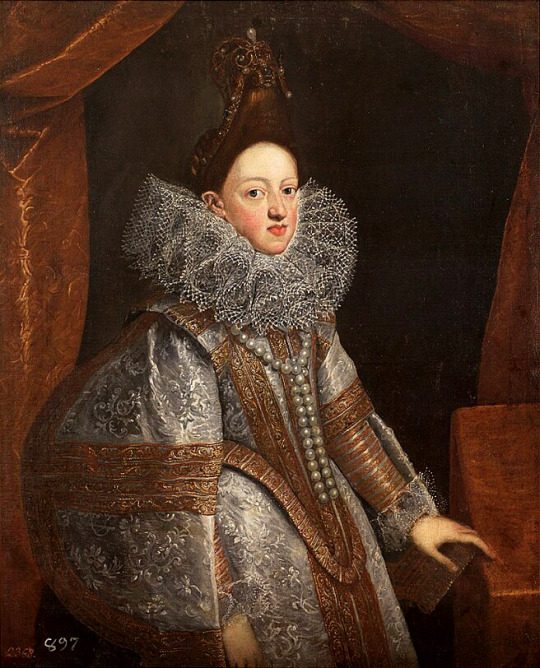
Constanza de Austria
attrib. to Bartolomé González y Serrano (Castilian, 1564 – 1627)
oil on canvas (88 × 108 cm), c. 1610
Embajada del Reino de España en Berna
#737652272766566400/qi0qOUG7#Bartolomé González y Serrano#[attributed]#Fashion#House of Habsburg#House of Vasa#Constance of Austria#Habsburg Monarchy#Archduchy of Austria#17th century#1615#Baroque#Museo del Prado#portraits#oil on canvas#paintings
2 notes
·
View notes
Text

The Swedish warship Vasa. It sank in 1628 less than a mile into its maiden voyage and was recovered from the sea floor after 333 years almost completely intact. Now housed at the Vasa Museum in Stockholm, is the world's best preserved 17th century ship
Tap for more
38K notes
·
View notes
Text
Life on board a 17th century warship
The sailing crew was divided into two watches under the two lieutenants, each working for four hours while the other rested. While off duty, they were expected to stay below decks and out of the way, but could be called to work at any time if all hands were required, such as when anchoring or making a major sail change. When below, they probably tried to sleep as much as they could, since the four-hour schedule is not natural and quickly leads to fatigue. When not sleeping, they probably used much of the time off watch to mend their clothes and shoes, but they might relax with games, music or a popular new pastime, smoking, although this was only allowed in the cookroom.

War Ships 17th Century, by Jefferys, Charles W. 1942 in: The Picture Gallery of Canadian History Volume 1, p.99
Food was also prepared in the cookroom, a brick-lined hearth in front of the mainmast in the hold, and carried up to the gundecks in buckets, where it was doled out into big wooden bowls. Depending on the ship, food could also be prepared in the galley, which was located in the forecastle or midships.
Each man had his own wooden spoon, and some had wooden plates, but most ate from the bowl shared by a mess, a group of six or seven men who ate and lived together. They drank weak beer, "ship's ale," from a shared wooden tankard. The base of the diet was salted meat for protein and dried peas and bread for carbohydrates. Barrels full of bones found in the hold show that the meat was mostly beef, with a little pork and mutton, as well as fish and poultry. Interessting fact was that some of the crew were prepared to supplement this, as fishing equipment and hunting weapons were found in shipwrecks like the Vasa, as well as the bones of roe deer, moose, and grouse. The skeletons of chickens suggest that a few fresh eggs were available.
As in other navies, they did not issue uniforms in that time, the men had to buy or make their own clothes. In some cases cloth was provided as part of their salary, but the typical sailor's clothing was the same as the clothing they arrived in from the farm or town: a linen shirt, a short, skirted woollen doublet (jacket), wool trousers that ended below the knee, woollen socks, and leather shoes. Many had broad-brimmed hats or conical caps. The cloth varied from coarse homespun to imported dyed fabrics, but almost all sailors sewed strips of contrasting cloth or even lace down the outside seams of their trousers in imitation of the clothing worn by the well-to-do. Clothes had to be hard-wearing, since most people could not afford more than one set.
The senior officers lived aft in the cabins of the sterncastle, where they had more space, glass windows, proper furniture, and ate their meals from pewter or earthenware table service. They had finer clothes, but as more than one visitor to Sweden from the continent remarked, it was difficult to tell the nobles from the peasants, since they dressed alike. The officers also had to share their accommodation, sleeping in pairs in narrow double beds, but the cabins were built to resemble the interior of houses ashore. The great cabin, where the king or an admiral would stay, was fitted out like a room in the royal palace, with fine panelling and carved sculptures that emphasised the power of the people who lived there.
The 17th century was a violent period, and both on shore and at sea brutal punishments were prescribed for even minor crimes. Conscripts often came from rough backgrounds, but discipline was essential for the smooth and safe functioning of a ship. In crowded conditions, small disagreements could easily blow up into fights, grumbling could turn to mutiny. Officers had to earn the trust of the men they commanded, but needed the option of punishment for the intractable. The articles of war specified that a person causing a fire was to be cast into the same fire, a person starting a fight was to be stabbed through the hand with a knife, blasphemers and those speaking ill of the king or his officers were to be keelhauled, murderers should be tied to their victims and thrown in the sea. In practice, a captain who had to use these punishments too often risked losing the respect of his men and his fellow captains and could not rule for long.
281 notes
·
View notes
Photo
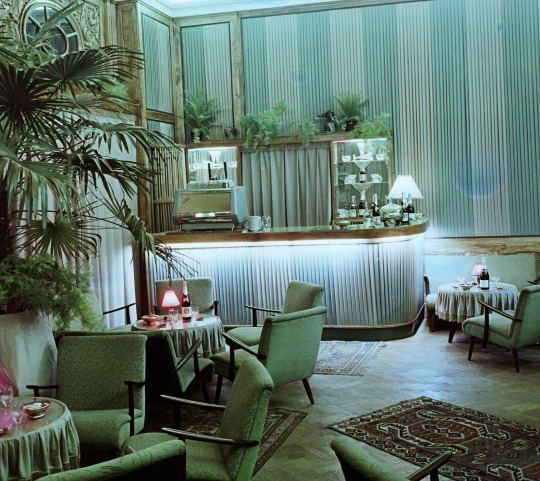
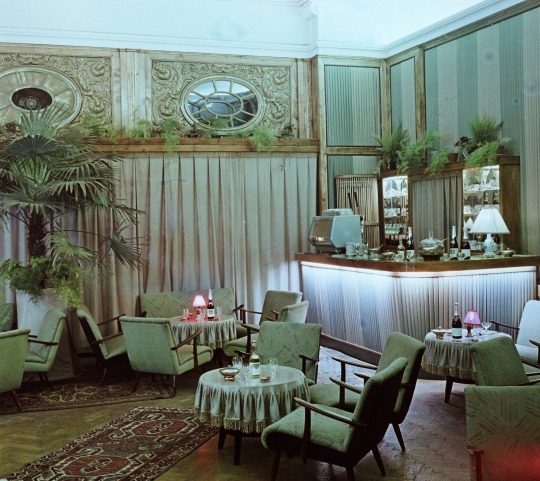
Espresso bar, Vasas House of Culture (today Csili Cultural Centre), Budapest, 1958. From the Budapest Municipal Photography Company archive.
2K notes
·
View notes
Text
* Swedish Culture *
As my exchange semester is coming to an end, I want to share with you what learned about Sweden the last 6 months
Trains drive on the left side of the tracks. On dagen H, everyone switched from driving on the left side to the right side, except for trains. Swedes will look at you funny for bringing that up.
On every product there is a detailed description of how each part of the product should be recycled. We need to do that everywhere.
Fika <33333333
There are no rules for biking here. It is chaos. As a Dutch person I'm very confused
Love to the academic quarter that allows me to be 15 minutes late to every lecture
I think Gävlebocken is a tradition we need to keep. Especially the burning part of it.
Why does everything close so early during the weekends??? What am I supposed to do??
Ikea has my heart. And a lot of my money.
Sun setting at 14.30 makes me want to eat dinner so early already
Also, the cold makes my hair literally so static? Does anyone know what to do about it?
I can never live without kanelbullar again
The amount of lactosefree options there are everywhere! Love it!
Swedes will be sitting outside of a café even when it is -2 degrees. I have the utmost respect for them.
Why do you close everything for the winter? What am I supposed to do now??
The Ikea stereotype is no joke. Everything I own is from Ikea. Everything my friends own is from Ikea.
I miss cheap alcohol :(
Where are there random loose chairs and tables in your trains? Where do they come from? Why are they there?
Affordable housing <333
Little kids in their little snowsuits with their little snowboots are the cutest thing ever
In small towns, you can find like 7 different Japanese restaurants. Nothing else tho.
Kötbullar are so cheap. I love them. I buy them all the time.
I need to know, why are you so obsessed with Thailand as a country?? I need answers.
I'm not made to withstand -15 degrees. No Swede bats an eye.
Also, choirs are a very big thing??? I wish I could sing well.
Did I already mention kanelbullar? <33333
People ask you if you've already been to the ABBA museum. You have not. You are also not planning on going. Still, people ask you.
The Vasa Museum is a very controversial topic.
The red barns you see everywhere are painted with animal blood. You like to point that out to everyone who comes to visit you.
You have not seen the sun in days. You live on vitamin D-supplements and nothing else
Icehockey looks 75% of the time like very aggressive flirting. You know, like the kdramas
You are sitting in the bus quietly. There are people checking the tickets. You have a ticket. Suddenly, there are 4 people standing over you checking your ticket. There's only 5 people in the bus.
16.00 is rush hour. That is very early.
People will not move out of the way for you. Not in the supermarket, not on the train or on the pavement. There have been many times I have had to walk on the road because people will not move for you.
What is lingonberry and why do you put it in everything?
Why do your parties start and end so early?? Why is 4.00 considered "late"?
Just like the Vasa museum, Gamla Uppsala is a very controversial topic.
Tiny rocks are strewn over the street to combat the ice and snow. They get stuck in your shoes. There is a tiny rock collection on the floor of the hallway now.
It is -20 degrees Celsius outside. You see a dude wearing kaki shorts.
Tomten has my heart. He is so tiny.
Student discounts <3333
#I'm finally going homeeee#it was such fun tho#but I'm very happy to see my family again#language learning#swedish#swedish langblr#svenska#swedish vocab#langblr#swedish culture
293 notes
·
View notes
Text
Sometimes I watch Young Royals to make heart eyes at the pretty boys and to swoon at their love.
Other times I wonder how much thought was put behind the choosing of each name, specifically that of Queen Kristina. Why Kristina? The irl Queen Kristina wasn't a random sidenote in Swedish history after all, so that had to have been intentional, right?
Then I start spinning wild theories about Wille's house (no way is he a Bernadotte) and jotting down notes and wondering how unrealistic it would be if maybe the life and times of the irl Queen Kristina (and her father) was when the timelines diverged. How could you make some pretty drastic changes to events 400 years ago without going full on butterfly effect and completely changing everything about modern Sweden and Europe and the world?
Not that we know much about the world of Young Royals outside of Hillerska, so many things really could be different …
aka I somehow managed to arguably, convincingly prove to myself that, with plenty of brain gymnastics, Wille could totally be a Vasa in theory and maybe one day I'll sit down and put that into a somewhat coherent essay which should totally be no longer than thirteen pages at most … or maybe I'll stick to writing abo porn idk.
Anyway, aren't those boys pretty?
#this post was sponsored by me wondering about Wille's coat of arms#for the five billionth time#this time for The Prince and the Barista#so at least there was some reason for it#wilhelm is not a bernadotte#so that means there have to be (even more) differences#crown prince wilhelm#queen kristina#young royals#young royals meta#random ramblings
62 notes
·
View notes
Photo

One of the most revolutionary events in English history, the Dissolution of the Monasteries (sometimes referred to as the Suppression of the Monasteries), was the set of administrative and legal processes between 1536 and 1541, by which King Henry VIII disbanded monasteries, priories, convents and friaries in England, Wales and Ireland; in effect, sacking and looting them for their income, land and assets.
In order to grasp the impact of the Dissolution, it is necessary to understand that in the late 1530s there were nearly 900 religious houses in England (around 260 for monks, 300 for regular canons, 142 nunneries and 183 friaries). As such, some 12,000 people in total (4,000 monks, 3,000 canons, 3,000 friars and 2,000 nuns), were engaged in carrying out the functions of those religious houses. To put this in context: if the adult male population was 500,000, one adult man in fifty was in religious orders.
Henry was given authority by the Act of Supremacy, passed by Parliament in 1534, which made him Supreme Head of the Church in England, thus separating England from Papal authority; the King's position further strengthened by two Acts of Suppression (1536, and 1539). The policy was originally envisaged as increasing the regular income of the Crown, and much former monastic property was sold off in the 1540s to fund Henry's military campaigns; though by the time Henry VIII turned his mind to the business of monastic reform, royal action to suppress religious houses already had a history of more than 200 years.
The first case was that of the so-called, Alien Priories (some, merely agricultural estates with a single foreign monk in residence; others, rich foundations in their own right, such as Lewes Priory, which not only answered to Cluny of Paris, but sent money overseas, too).
Given the fairly constant state of war between England and France in the Late Middle Ages, the money sent to France by these Alien Houses was a matter of significant grievance in England. As such, the first sequestrations of the assets of the Alien Priories began under King Edward I, continued in the reign of Edward III, and still further continued by act of Parliament in 1414, under the authority of Henry V.
Money and land acquired by the Suppression greatly increased the royal purse, though some of it was also used to found educational foundations: most often setting up new colleges at both Oxford University and Cambridge University. Further instances, include: John Alcock (Bishop of Ely), acquiring the Benedictine nunnery of Saint Radegund to found Jesus College, Cambridge (1496), and William Waynflete (Bishop of Winchester), acquiring Selborne Priory in 1484 for Magdalen College, Oxford.
Dissolution of Monasteries was not an act exclusive to England. In 1521, Martin Luther published 'De votis monasticis' (On the monastic vows), a treatise declaring monastic life was not compatible with the true spirit of Christianity. In Sweden in 1527, King Gustavus Vasa secured an edict allowing him to confiscate any monastic lands he deemed necessary to increase royal revenues; and in Denmark in 1528, King Frederick I grabbed 15 of the houses of the wealthiest monasteries and convents.
King Henry VIII's chief political and legal architect in the Dissolutions was Thomas Cromwell (also instrumental in monastic suppressions instigated by Cardinal Wolsey); though Henry is also said to have been influenced by Desiderius Erasmus and Thomas More; both of whom ridiculed such monastic practices as repetitive formal religion and superstitious pilgrimages for the veneration of relics.
Most parish churches had been endowed with Chantries (each maintaining a priest to say mass for the souls of their donors), and these continued until they too were dissolved under the Chantries Act (of 1547), by Henry VIII's son, Edward VI.
Along with the destruction of the monasteries, the related destruction of the monastic libraries is said to have been on a catastrophic scale: Worcester Priory, for example (now Worcester Cathedral), had 600 books at the time of the dissolution; only six of them are known to have survived intact to the present day.
Similarly, the Abbey of the Augustinian Friars at York, had a library of 646 volumes, of which only three are known to have survived.
48 notes
·
View notes
Photo


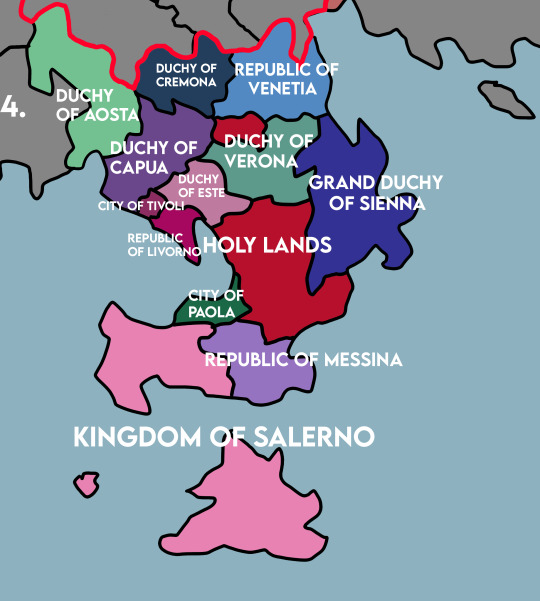
eusalia retcon!!
eusalia is the continent in my Sophie of Rostock story which will be resuming soon! it is HEAVILY inspired by early nineteenth century europe!! I did make a map when I first started the story but now I really hate it and wanted to revamp it and add more detail. anyway so in the continent there are two distinct regions which are heavily divided, germania and vista. this is the map as of 1809 (when the story starts)
the germanic empire (heavily inspired by the Holy Roman Empire) is purely ceremonial and has no real power, each principality governs itself with the emperor elected by twelve electors as a mere figurehead. the emperor of germania has for the past 400 years been from the house of Augustinia who hold lands all across the continent. the augustinian family also controls chambery, which was acquired in 1695 after the 3rd Calais-Augustinia War. the germanic empire includes two kingdoms, the kingdom of weimar & the kingdom of wardenburg. previously the kingdom of tyrol which is controlled by the Augustinians was considered a part of the empire but the Augustinians formally removed it from the empire’s designated territories and made it a personal possession. the archduchy of graz & the kingdom of augustinia are also part of the augustinian domains. Charleroi was also a part of the Augustinian Domains until 1735. in germania for the past fifty years there has been a constant rivalry between the kingdom of wardenburg and the augustinians who try and influence all of the other states of the empire.
meanwhile in vista there are a plethora of different independent states. btw in this map of vista I made a mistake, Aosta is a KINGDOM not a duchy anymore. so Aosta & Salerno are the biggest powers in this region along with the Patriarch who is the religious religious leader of the Jacobans who also rules the Holy Lands. The Royal House of Aosta is the longest ruling one in Vista, holding the duchy of Aosta since 1104, it was elevated to a kingdom in 1805.
in general windenburg, calais, augustinia, wardenburg, and beloshov are the great powers in the continent. beloshov has only recently advanced under the reign of their current monarch, the empress elizabeth and has been considered a great power following their many wars with the hafsah caliphate. from 1790-195, beloshov fought in the stravian wars of liberation, resulting in tetovo, tirana, and athenia gaining their independence from the hafsah caliphate.
currently there is one major war raging through the continent, the war of calais succession. in 1784 the House of Everaux was dethroned in a bloody revolution resulting in the execution of several members of the government. in 1787 the House of Montpellier, a cadet branch of the House of Everaux, were put on the throne as the Duke of Montpellier was seen as a liberal. However in 1805 he was dethroned as well whereupon a revolutionary chaotic government led by radicals reeked havoc upon the continent, invading Charleroi and northern Almeria. In 1808 the radical government was disbanded and Calais was invaded by the allied forces including Windenburg, Beloshov, Wardenburg, and Frisia. However a conflict erupted when the allied powers had a disagreement upon which family should rule Calais now, the Everaux or the Montpellier family. Beloshov, Windenburg, Almeria, Salerno, and Capua all support the Everaux family taking the throne. Meanwhile the House of Montpellier is supported by Wardenburg, Charleroi, Augustinia, Aosta, and Frisia. This has caused a war which has spiraled throughout the continent, however the claimant from the house of Everaux, Prince Louis Ferdinand (Louis XII), landed in Calais with an army of 30,000 and has taken the capital, Magnolia with support of Windenburgian troops.
another current thing going is that in vasa, prince karl (second son to the king) has plotted a coup against his brother and father with the help of beloshov and other conservatives in vasa because they do not support his liberal policies + beloshov just wants to cause chaos in vasa because they to expand their borders toward vasa (beloshov owns the grand duchy of alstein). but with sophie’s potential marriage beloshov will stop supporting the everaux in the war of calais succession & they will stop supporting the coup against the king of vasa who is her mom’s cousin! anyway this was a LOT and probably very complicated. my story will be returning soon hopefully!
#SophieOfRostock#SOR#worldbuilding#sims4#ts4#ts4 storytelling#royals#royalty#sims 4 royal story#story#ts4 story#map#sims 4 map
46 notes
·
View notes
Photo

Sofia Johansdotter Gyllenhielm (1556/59 – June 1583), was a Swedish noble, the illegitimate daughter of King John III of Sweden and Karin Hansdotter.
She spent her early childhood with her mother in Turku Castle in the Duchy of Finland. In 1562, she and her brother Julius (1559–1583), though not their younger sister, were removed from their mother's custody and kept in their father's household when he married Catherine Jagiellon. When their father and stepmother were imprisoned in 1563, Gyllenhielm and her brother were given into the care of Anna Andersdotter, spouse of Jöran Persson. Persson accepted a bribe Catherine gave him in exchange for returning the children, but he still did not do so. They were returned to their father when John deposed Eric XIV and took the throne in 1568.
Gyllenhielm became a lady-in-waiting to her aunt Princess Elizabeth of Sweden in 1576. The same year, she was engaged by her father to his favourite, French immigrant Baron Pontus De la Gardie (1520–1585) as a reward for his service for her father. Sofia, her sister Lucretia Gyllenhielm (1561–1585) and their brother Julius were ennobled in 1577 and given the surname Gyllenhielm.
The wedding was held at Vadstena in Östergötland on 14 January 1580. It was a grand ceremony with many guests, and during the ceremony a church gallery collapsed under the weight of the congregation, resulting in the death of one person. This was interpreted by Catholics present as a divine verdict on heretics.
In 1581, Gyllenhielm accompanied her spouse to his command in Swedish Estonia.
She died giving birth to Jacob, at Reval, in 1583.
1 note
·
View note
Photo

Władysław IV, King of Poland by Frans Luycx.
#Frans Luycx#królestwo polskie#królowie polscy#kingdom of poland#house of vasa#dynastia wazów#full length portrait#full-length portrait#niech żyje król
5 notes
·
View notes
Text
Where Is the Revenge’s Toilet?
In ep 1 Stede gives a tour of the Revenge that includes the “en suite,” a small room with a toilet and some kind of bathing bucket. But we’re never shown where on the ship it is, exactly.

Stede of course has a bathroom next to his cabin, but from what we can see it only has a bath, no toilet.

So does this mean Stede uses the en suite along with the crew? Not necessarily! On navy vessels of the period, the officers used toilets in the quarter galleries—the enclosed balconies that stick out on either side of the stern. Presumably this is because of the way they hang out over the water, so the waste can fall straight into the ocean.

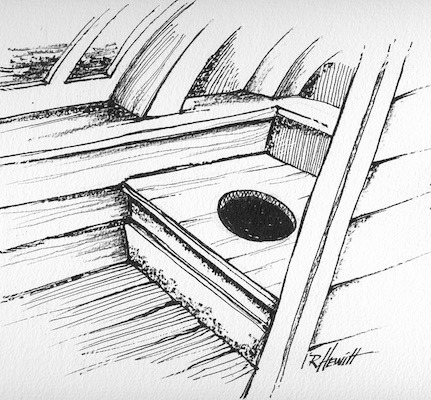
Right: “Seat of Ease off the Captain’s Quarters” by Robert G. Hewitt © 2020.
On the Revenge, the port gallery contains Stede’s bed, but there are some spaces around it that could maybe house a toilet. The starboard gallery is a mystery: yes, secret passage, but also maybe toilet(s)?

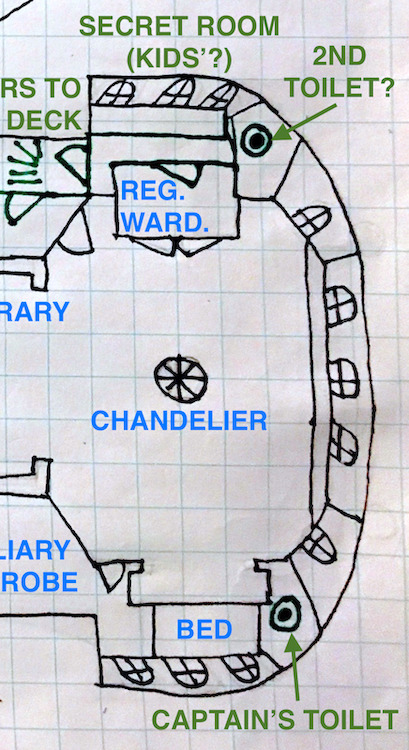
As for the crew, there’s the time-honoured tradition of just pissing over the rail, but in heavy weather you might lose your balance and fall overboard. By the 1700s ships were built with a pissdale, a basin or trough placed just inside the low walls around the main deck. It acted as a urinal, funnelling the urine off the side of the ship. I can’t say for sure the Revenge has a pissdale, but it seems like something Stede would include. I wouldn’t be surprised if Jim figured out a way to use it too, maybe with an 18th-century P-Mate.

“Pissdale on Deck of Ship” by Robert G. Hewitt © 2020.
But of course this wouldn’t do for, ahem, solid waste. Below is a 1728 diagram of a ship’s toilet, labelled “necessary seat” (14), also called the “seat of ease,” as in the earlier illustration. It’s located in the ship’s head (or beakhead), which is why the word head came to mean toilet, as in “I’m gonna hit the head.”

The deck of the head was also partly open—slatted rather than solid—to let the waves in to rinse everything out, which is why toilets were usually placed just above the water line. Here’s the beakhead of the Swedish warship Vasa from the 1620s, with two box-like toilets. You can see the remains of a seat on the right-hand one.
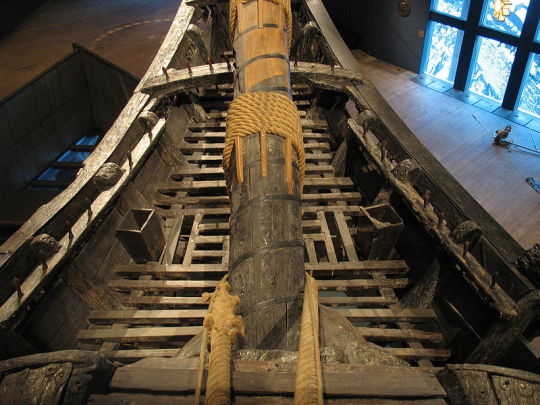
As for the Revenge, it makes sense to put the en suite in the head, somewhere where the toilet can open directly over the water. Let’s look again:

Left of Pete there’s a vessel with a handle sitting on a small barrel. This could be a scoop and a covered bucket of seawater for “flushing,” i.e., sluicing the inside of the toilet with scoops of water. This only makes sense if there’s somewhere for the waste to go; if the toilet was a stool with a chamber pot inside, you could just rinse it out when you dumped its contents.
Also, look at the right-hand wall. It’s decorated with moulded panelling (carved squares), which seems pretty fancy for a toilet room. Unless it’s a continuation of the fo’c’sle’s front wall.

I was very proud of this theory until I noticed the panels don’t match. Alas.
There’s also a noticeable gap in the toilet room’s right wall. It could just be the door, but my theory is it’s an open gap to make room for the bowsprit higher up the wall (see diagram below).
Another piece of the puzzle is the pattern of light and shadow against the walls. We don’t see any other shadows like it (except in the “ball room,” which is another post). It doesn’t match any of the gratings we’ve seen, which make a crosshatch pattern, nor does it line up with the ship’s railings. Does this matter? Well, look, someone on the film crew had to cut out that shape and stick it in front of a light, or however they do it, to cast that specific shadow, so I’m guessing it points to something.
My first guess was that the light here is shining through the railing around the head, which is a different shape from the ship’s other railings. If the head’s deck isn’t solid—like on historical ships—the light could be coming from behind the railing and shining through the slats.

But…the deck of the Revenge’s head looks pretty solid, as far as I can tell. Still, we haven’t seen the entire deck…
Just leave me my delusions, okay?
So, finally, here is my new improved diagram of the head:
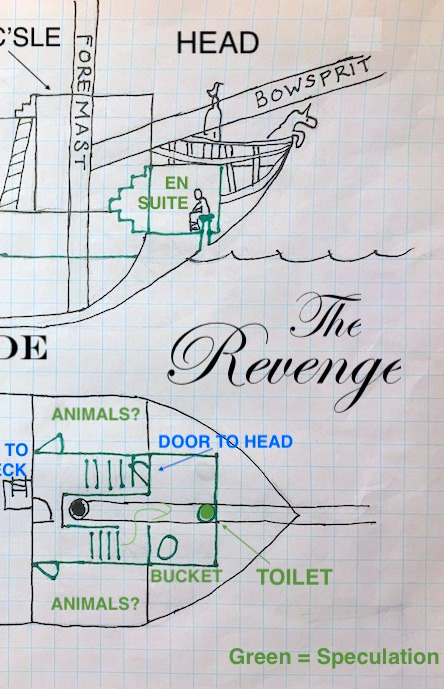
Is it accurate? Who can say. It’s really all headcanon at this point.
(Sorry.)
#ofmd#ofmd meta#mapping the Revenge#nautical history#historical ships#history of toilets#truly obsessive attention to detail
57 notes
·
View notes
Text

The Swedish warship Vasa. It sank
in 1628 less than a mile into its maiden voyage and
was recovered from the sea floor after 333 years
almost completely intact. Now housed at the Vasa
Museum in Stockholm, is the world's best preserved
17th century ship
Help and support
2K notes
·
View notes
Text
Stockholm Week 7: Travel Week 1
Hej igen!
I had a bipolar week: the beginning of the week was full of presentations but the end of the week was full of laughter :)
Let’s begin!
2/28 Wed
It has been a while since I had two study trips in a day. I learned about the New Slussen Project, which is the reason for all the construction around Slussen. The planning behind the project was astoundingly complex and comprehensive, considering all social, environmental, and economic factors.

Model of the new Slussen project design
The next study trip was a real guided tour based on the Swedish crime fiction novel, The Girl with the Dragon Tattoo. We walked around Monteliusvägen to Michael Blomkist’s apartment, the cafe where the movie was filmed, and viewpoints that showed the city at a glance.

A picture of a gallery I peeked into before the field trip

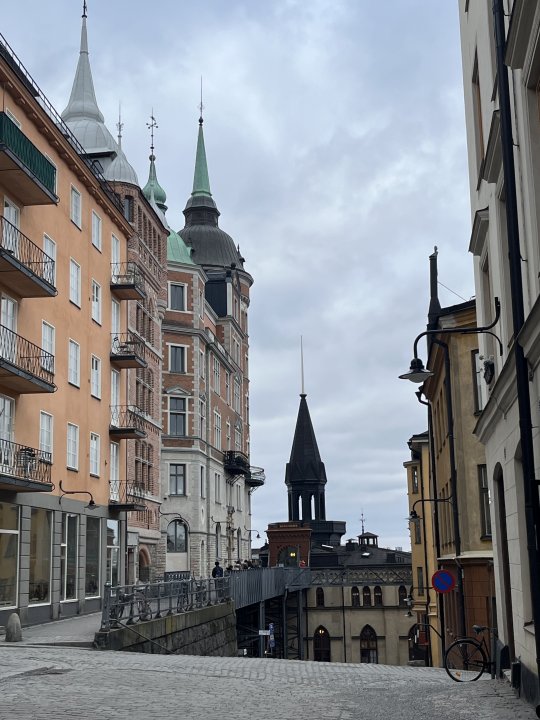

The view was gorgeous. It's not too far from my apartment too!
When the tours were over, I stopped at the Coffee House and yapped with my friend for a bit before going home.
2/29 Thu
Today was the big D-day: a 10-minute presentation on the case study done in my core course. I booked a room in DIS to practice until class. I ate my packed lunch and finished up my last touches.

My messy hair ;-; The sun was out and I needed a break
Turns out the presentation was informal but I guess that was for the better.
At home, I couldn’t rest as I had to prepare for my other presentation for Swedish and read half of a book for Crime Fiction class tomorrow. I made the mistake of reading in my bed and fell asleep eventually.
3/1 Fri
My team successfully finished the presentation and ate the pepparkakor that our teacher prepared for us. It is a thinner version of ginger cookies with a taste of Sweden.
As a little treat after school, I ordered TooGoodToGo at an island I’ve never been to. It was such a smoggy and windy day (especially because the bridge I had to pass was near a huge lake) but I managed to arrive at the bakery in one piece.

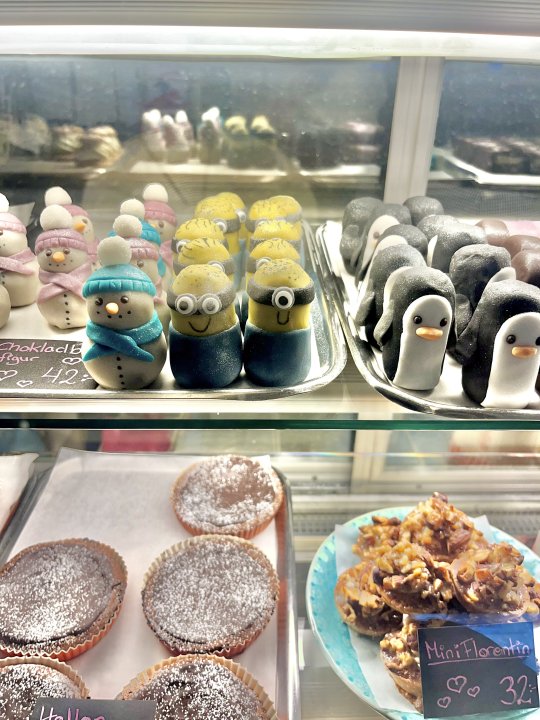
The bakery had so many cute chocolate pieces < 3
I caught up on my sleep for the rest of the day. 4 hours of nap before sleeping for real at night ;)
3/2 Sat
Finally, travel week 1 break began! My family came to visit Stockholm while I was here. We had no specific plans in mind, so we spontaneously decided on places to go. We left Airbnb at 5:30 pm when the sun was all set (...) but we still had a good time walking around T-Centralen and Gamla Stan.


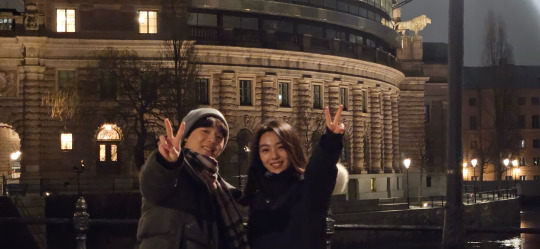

It was nice seeing my family again < 3
3/3 Sun
We had a slow morning but made it out of our house by 1 pm.
Our first stop was Gamla Stan since we could not see anything in the dark yesterday. I took them to the main photo spots first.

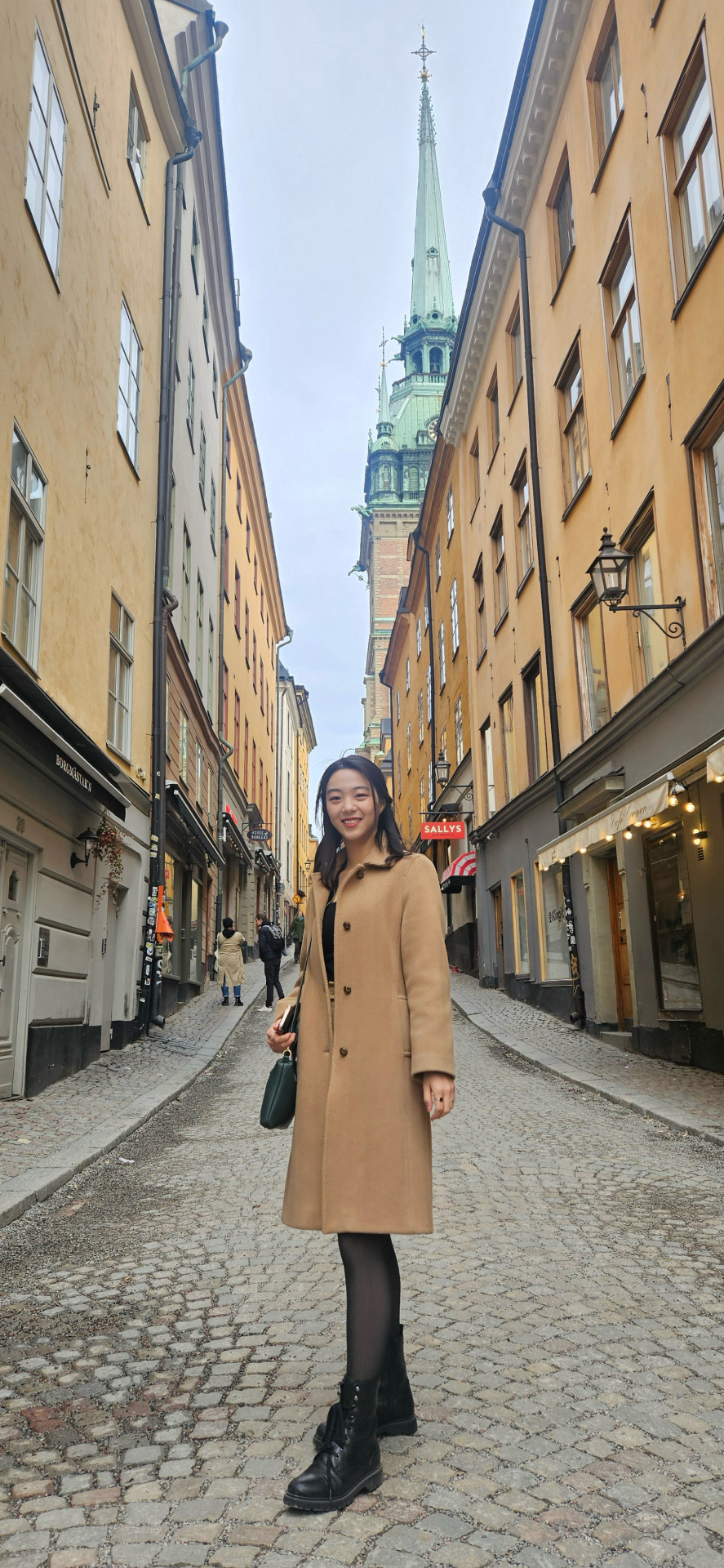

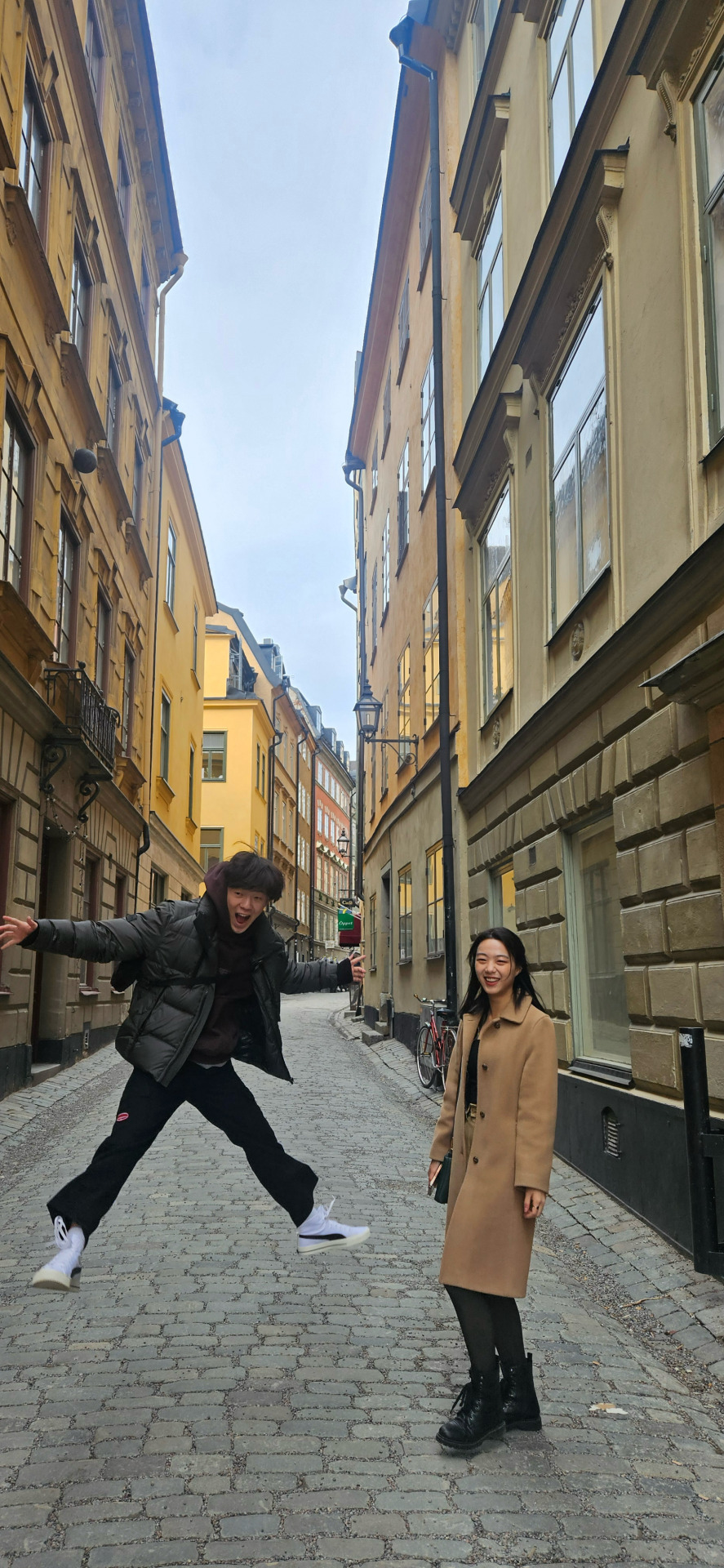


Happy happy happy '◡ '

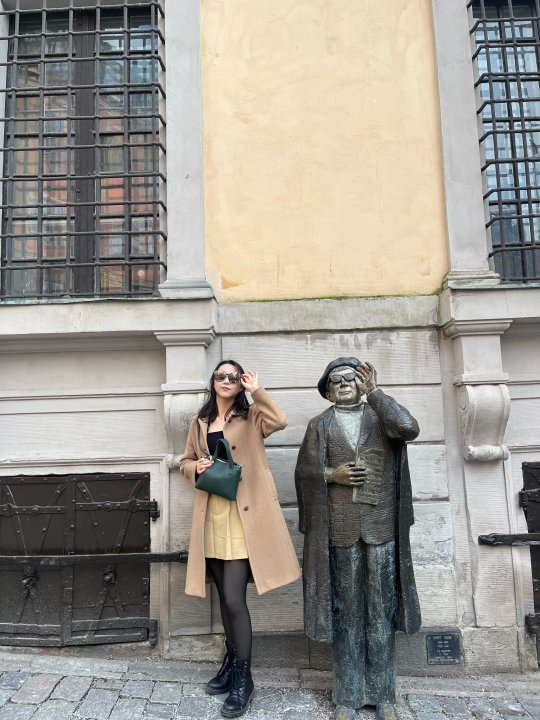

If you remember this place from my prior posts, you're a real one < 3
My dad then led the way to Stockholm’s narrowest street, Mårten Trotzigs gränd. It is only 90 cm (~35 in) wide.



I took some great snapshots for my brother
From far away, we saw a commuter ferry departing and abruptly decided to take it. We ran and ran and ran to make it in the departure time. We found out where we were headed once the ferry steered toward the temporarily closed amusement park on Djurgården Island. I felt like I hadn’t been on impromptu journeys for ages, so this kind of random traveling brought me so much joy! The island was bigger than we thought, and it was then that my dad discovered something from the map. The island we were on was the island with the Vasa museum! On the subway to Gamla Stan earlier on, we had made a plan to go to visit the Vasa museum later today. Without a clue, the ferry took us to the right place at the right time. We were so amazed and couldn’t stop talking about it for a good hour (and now I’m writing it on my blog post).
Since we were there already, we went to the Vasa museum. It is a popular museum with a restored ship that sank back in the 1600s and recovered after 333 years, in the 1900s. I was impressed by the grand size of the ship and the salvage operation.

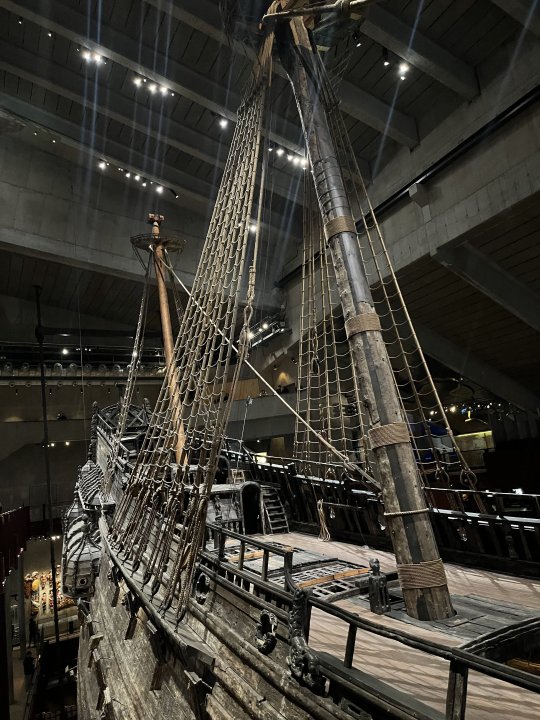
I still can't believe this magnificent yet delicate ship sunk 10 minutes after its departure
We took a thorough scan of the six floors and finally left when we were satisfied. A beautiful sunset was awaiting us outside.
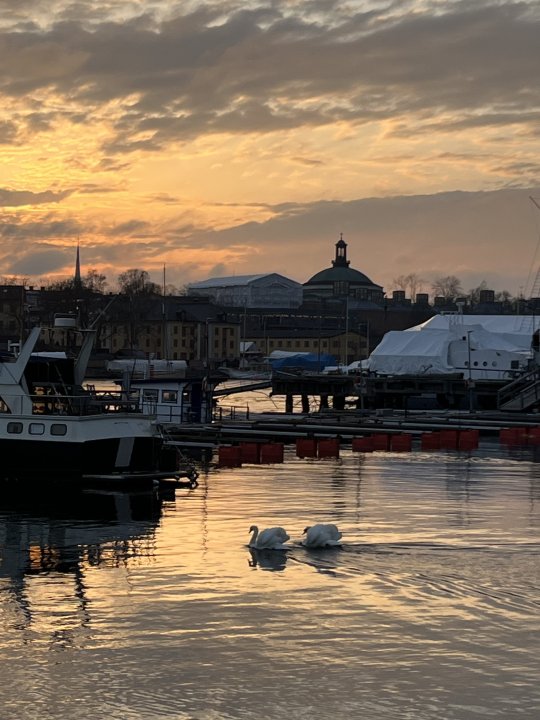
Swan couple < 3
This time, we took a tram to go back to Gamla Stan for fika. Fika and Wine was our first destination. We ordered Swedish meatballs and shrimp salad as our main dishes, as well as delicious desserts with coffee.

Can’t describe the deliciousness in words < 3
For the rest of the evening, we enjoyed Gamla Stan with street lights on, going into souvenir shops one after another like real tourists.

I loved the owls in this store but my wallet said no to all of them :(
The past few days have been relaxing, and I can’t wait to spend more time with my family :) They are wonderful photographers (as you can see from the pictures in this post) so I'll have tons of more photos to share in the following days. Good pictures always brighten my day <3
I will let you know all about the rest of my break next week!
Tack,
Jiwoo Kim
Chemical Engineering
DIS Study Abroad in Stockholm, Sweden
4 notes
·
View notes